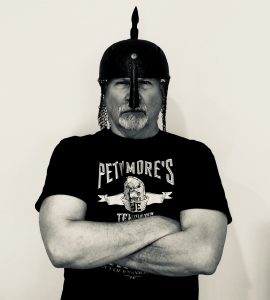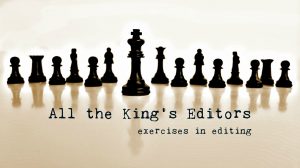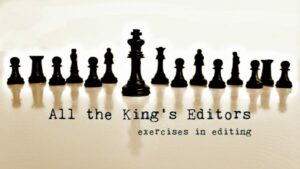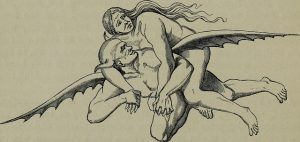Posts by David Corbett
In my last post (“Inspired to Emulation—or Preparing to Jump“), I talked about The Rule of No Rules, and how reading other writers you admire will provide the best writing advice you will ever receive.
Not long after the post went up, one of my favorite novelists, Adrian McKinty—who writes brilliantly about Northern Ireland during the Troubles from the perspective of a Catholic detective serving in the overwhelmingly Protestant Royal Ulster Constabulary—posted the following letter on Twitter. He composed it to an aspiring author who had asked his advice on this whole writing business. This is what Adrian wrote in response (the recipient’s name has been removed for the sake of privacy ):
I’m tempted to end this blog post here, because I couldn’t possibly say anything as perfect, but that would be cheating, or lazy, or both. So instead, I’m going to talk a little about my writing process, and in so doing I ironically intend to prove that Adrian is absolutely right—there are no rules. (Incidentally — for more on Adrian and his truly wonderful books, visit his blog The Psychopathology of Everyday Life.)
Read MoreLeap of Faith–Krabi Thailand (Photo Credit: Christopher Johnson)
One curious consequence of writing a book on writing is the inescapable sense of humility that descends during the process. (I’m under deadline this week for my next book on craft, this one titled The Compass of Character. I’ll discuss it at greater length in the weeks to come, but for now I’m simply invoking it as my excellent and not-to-be-questioned excuse for a relatively brief post today.)
As a teacher and author of writing guides, I’m obliged to present techniques and strategies for successful fiction. Techniques and strategies, however, require a generalized idea of how to go about things. Concepts such as character arc and three-act structure and backstory exploration inevitably conjure guidelines that demand attention if not strict adherence.
This how-to approach can become trivialized into “Five Ways to Make Your Characters Jump Off the Page!” It can also be maddeningly vague because the only rule is there are no rules.
The Rule of No Rules is especially on my mind of late. While collecting examples for the guidelines I discuss in my book, I was inevitably made aware of how any novel worthy of being called good, let alone great, somehow squirms out of the stranglehold of accepted convention like a slimy piglet.
Whether the author was simply following her instincts or observing a carefully constructed plan—usually based on turning some accepted idea of how to write on its head—the truly remarkable books I have used to illustrate certain points all too often reveal themselves to be not just illustrative but sneakily subversive of what I’m trying to say.
This may simply be a reflection of another accepted truth, that the best stories give readers what they want in a way they don’t expect. This in turn echoes another truth, that stories should be both impeccably logical and yet surprising. And yet how does one teach that? How does one teach: Follow the path to the cliff’s edge, then jump?
Read MorePhoto “face time-2” by Albyn Davis
No, this isn’t about writing dishonestly. Quite the contrary.
I’m returning to a topic I’ve touched on before, but with a different slant this time around. Please bear with me.
We live in an era of such extreme social and political division that if often seems tensions cannot resolve without matters coming to blows—or blood. The increasing number of mass shootings underscores this point, as does online acrimony and the testimony of virtually every retiring senator, regardless of party, that something is broken in our current political culture.
Writers are not in the division biz. We’re in the understanding biz. Every book in some sense attempts to address a truth that the writer felt was previously overlooked, undervalued, or misunderstood.
Truth, though, is a tricky critter. It conjures analogies to greased pigs and invisible songbirds.
Let me lay my cards on the table: I do not believe truth exists objectively, like this desk in front of me or the moon. I’m schooled in this position by a long line of American Pragmatists, most notably William James, John Dewey, and Richard Rorty.
James famously said, “What’s true is what works,” and earned the eternal scorn of European philosophers whose belief in truth was very much grounded in Platonic and Kantian idealism and mathematical certainty.
But James’s point was really quite profound. He was implicitly asking: How do we know something is true? And his response was: When we use it, we tend to be more successful than not.
So when I say a book—and for our purposes here, I mean a work of fiction—attempts to address a truth previously overlooked, undervalued, or misunderstood, what I mean is that the writer, in posing the crucial story question, What if…? in some way hopes to show that certain ways of acting in the world—whether believed to be conventionally “right” or “wrong”— achieve their desired ends or don’t.
Does courage always win the day? Honesty? Love? Faith? Family? Or are we better off embracing skepticism, enlightened (or naked) self-interest, moral flexibility, violence, power? Is there a middle ground? If so, who does it favor? Do we, as novelists, even have to decide? Or is our job to show how all of these inclinations collide and interact and contaminate each other in the endless scrum known as human life?
Milan Kundera, in The Art of the Novel, refers to “the fascinating imaginative realm where no one owns the truth and everyone has the right to be understood…the wisdom of the novel.”
Fair enough. But how do I honestly go about creating and portraying characters whose beliefs are not just different from mine, but utterly repellent to me?
Read More“Myth is the garment of mystery.”
– Thomas Mann, Joseph and His Brothers
Last week, Donald Maass posted one of his predictably fascinating and eminently useful posts on the subject of awe in fiction, and how to create “marker moments” within a story that, well, let me use his own words to state the matter:
Marker moments are not plot points. They are emotional points, though events and emotions inevitably entwine. The point is to create places on the page wherein there are shifts in inner perception, understanding, certainty, security, or any other internal state. When a marker moment occurs it’s as if an anchor has pulled up from the sea floor in a storm, or conversely like when a steel piton is driven into a cliff face during a rock climb. Characters—and readers–become in those moments unmoored or newly secure.
He used the metaphor of a cathedral to illustrate that feeling cannot be conjured from structural elements alone. The overwhelming sense awe we feel when entering Notre Dame or Chartres or any other great cathedral (and even some of the humbler but still awe-inspiring chapels one can encounter if one looks) cannot be attributed to the stone or the stained glass or the buttresses from which it is built. Again, let’s allow Don to state the matter for himself:
What is therefore important and worth working on…is not only the plot architecture but also what cannot be built out of stone: the many moments of recognition, understanding and empathy that for readers sum up to a profound and transforming experience of awe.
Don also provided a number of cues that can lead us to just such moments, some of which I think are ingenious, such as (to name only a handful–my favorites):
There is much I consider both wise and practical in all of this—I especially believe that, by focusing on moments, we naturally envision scenes, and I have long contended that the most dramatically effective way to explore character, both through backstory and in the present-day dramatic arc of the novel, is by focusing on scenes, not narrative exposition or, worse, explanation.
I would add that the moments I typically search for are moments of helplessness or sudden, unexpected emotion or action when the character’s response goes beyond what their normal, day-to-day persona would have predicted. On the one hand, I look for moments of great fear, shame (loss of respect), guilt (harming others), betrayal, loss, sorrow, death; on the other I look for moments of sudden courage, pride, forgiveness, trust, and connection or love.
Read More
This post is the next in the ‘All the King’s Editors’ series, the brainchild of WU contributor Dave King. In this series, WU contributors edit manuscript pages submitted by members of the larger WU community, and discuss the proposed changes.
This is intended to be an educational format, and we hope this exercise will generate useful comments about the proposed changes–why the editorial suggestions do or don’t work.
Interested in submitting a sample for consideration? Click HERE for instructions.
* * *
Hello, everyone. Time once again for me to step into the editor’s chair. The following story is intriguing and well written with a strong, distinctive voice, and I think this writer is clearly capable enough, with another revision or two, of making this a fascinating story.
I have only a few line edits given the writer’s competence — largely punctuation (commas vs. semicolons) and capitalization (“Momma” when used as a proper name). Most of my other edits are cuts, where I thought the writer was either explaining too much or providing information that was better left implicit, rather than made explicit.
My principle focus will concern approach, specifically tone and perspective, and I’ll address all of that after the story itself.
Here we go:
* * *
My momma is a healer. She heals lost souls.
We live in a huge building with a doorman who holds open the door and leads us into the elevator. He even walks us to our apartment and opens the door with a special key. Momma gives him some money when he does this and he bows at the waist like in the old movies.
I go to a private school now. , mMomma says it’s important that I learn as much as I can ‘cause she don’t want me to turn out like her. That doesn’t make sense to me. I think she’s just grand. She’s beautiful with her bright red lips and her spiky heels and silky dresses. Her hair is black and shiny and it smells like Aqua-Net. It’s never out of place. Everywhere we go people stop and stare. I see them whisper and point. They must really think she’s something too.
Our life wasn’t always like this. There was a time when we didn’t have much to eat, ; when we lived in a small apartment, and slept on a mattress laid out on the floor, and ate our dinner out of a bag. I think that’s when mMomma was training for her job, before she learned how to dress and act. That was before she learned to make herself pretty, to put on her makeup and nice dresses and heels. But she studied real hard, she read magazines and watched the women on TV. She learned how to walk straight with her head in the air. I would giggle when she walked around with a book on her head but she got real good at it and now it hardly ever falls off.
Sometimes we would practice manners. She would set the table with plastic silverware and paper plates and cups and we would practice […]
Read MoreOn May 28, Sharon Bially posted a wonderful piece here on Writer Unboxed on linking motive to purpose. She defined purpose as:
[T]he unique gift we each bring to the world and always have. Our purpose has been leading us through our whole lives, in every aspect of our lives, and never changes. It is the solid, internal ground that each of us can stand on while the world is spinning out of control.
I liked this post so much I read its opening out loud to my students at the recent Wake Up And Write retreat in Boise, Idaho (where I was joined on faculty by fellow Unboxer Grace Wynter). I explained to the class that Sharon’s concept of Purpose dovetailed with what I refer to as the Yearning.
At the risk of being annoyingly repetitive, let me once again lay out briefly what I mean by the Yearning: It is the deep need shaping the character’s “dream of life”—the kind of person she wants to be, the way of life she hopes to live.
And yet most people (and characters) stumble through life barely aware of their Yearning—or, worse, they expend a great deal of effort trying to deny or escape it. (This is what Christopher Vogler in The Hero’s Journey refers to as the Resistance to the Call.)
The Yearning can be a harsh mistress. It demands of us a level of honesty, integrity, courage, and commitment that can feel overwhelming, and the shame of not living up to its dictates can be crippling.
Failing to live up to the Yearning’s demands, once they’re clearly recognized, can feel like a living death. Better to let the fog of distraction or denial obscure the Yearning a little longer. And so we head for the beach, hang out with friends, focus on our families, bury our faces in work, attend to the never-ending list of chores, get loaded, etc.
What good will it do to fulfill my Yearning? Chances are I’ll fail, and what would I honestly accomplish in this big, bad, dangerous world if I happened to succeed? Why would it matter? What difference could my fulfillment possibly make in the grand scheme of things?
This may explain why many writers, in order to raise the stakes, short-arm the Yearning and instead invest in an exterior goal that clearly registers as life-and death: rescue the miners, catch the killer, discover the cure. Here the character’s motivation is clear-cut, and the consequences of failure are obvious and dire. No need to delve into the sticky, gooey, vague, mysterious muck of the character’s Yearning or Purpose.
And yet, as Sharon rightly noted, this often leaves readers wanting. Motivations driven solely by exterior causes and consequences seldom provide a deeply meaningful experience for the reader. It’s not enough for the protagonist merely to get the job done—even when the job is saving the world. We will admire such a character’s capabilities but the emotional range of our engagement with the story won’t extend much beyond what we’d feel on a roller-coaster. To feel something deeper, engage more meaningfully, we need some inkling of why success at achieving the goal matters—not just in general, but specifically to the character herself.
This is where (again, as Sharon pointed […]
Read MoreThis is another installment in our periodic editing program here at Writer Unboxed. The piece I’ve chosen for this particular exercise shows some real talent in description, setting, pacing, and dialogue, and it was enjoyable to read.
That said, it lacked dramatic focus, and too much of what was happening felt muddled or underdeveloped, so that the extended scene that comprises the piece had considerably less emotional impact than it could have. Much of what I say here will be focused on how we might improve that.
One of the difficulties in editing the piece was trying to discern the author’s intent given the muddled emotions and desire-line in the scene. This created constant uncertainty as to how to go about improving the piece. (It’s also one of the reasons this post is so long–sorry.)
Another difficulty resulted from not knowing from the outset whether it was intended as a short story (because its title, “Knowing When to Quit,” suggested a self-contained whole) or a chapter in a longer work. Given the number of references to incidents and characters outside the text itself—for example, the death of Eddie’s best friend, Nick, and the existence of the “Agency,” etc.—I decided that it was part of a larger work, and that the title was intended as a chapter title .
I’ll first present the text as edited. I have used bracketed numbers referencing my changes, and employed underlining where I have added text. My comments as to why I’ve made the changes will appear with those numbers for reference after the edited text. Then I’ll discuss in greater detail the more developmental aspects of what I would propose if I were the editor on this project.
*****
Knowing When to Quit
The shiny spot on the bronze pig butt mounted above the entrance to The Brass Tail was tempting, but Josh preferred making his own luck. [1] The Marina district of San Francisco was eight miles and a world away from the sunlit streets of Sausalito. He’d left Kat there in the lengthening shadows, stubborn as ever in refusing his offer of help. Here, fog had reclaimed the streets, muffling traffic noises and sucking away the day’s warmth. [2]
Cold, damp, San Francisco fog air pooled around him Josh’s legs as he stood in the entry, taking . He stamped his feet and took a moment to absorb the energy of the room. [3] Despite her being eight miles away in sunlit Sausalito, Kat’s vibe saturated everything. She didn’t just own the place, she haunted it. [4]
Read More
The only etchings I’ve seen have been behind glass
And the closest I’ve been to a bar is at ballet class*
Last week Kathryn Craft and Don Maass both addressed particular issues related to portraying protagonists—Kathryn pointing out the essential role of willfulness, and Don exploring the crucial role of shame in defining what the character fears and what it will take to overcome it.
I’m going to turn the focus around on the character I call the Opponent, but others call the Nemesis, the Antagonist, the Adversary, or the Villain. (Some resist this terminology. The crime writer Les Edgerton rejects it outright, preferring instead Main Character #1 and Main Character #2, an approach I actually like a lot.)
I define this character as the one with the power, the will, and the desire to deny, destroy, or claim for himself what the Protagonist wants.
This can be as benign as a reluctant love interest, or a competitor for the same job. Even when the character commits genuinely bad acts, he may believe himself justified, whether out of desperation for a better course, out of devotion to a cause considered worthy or even noble, or some other belief that “the ends justify the means.” (Of course, these justifications may mask a deeper, truly insidious purpose, but I’ll leave that to another post.)
I’m going to focus here on something far more blatantly malevolent, and discuss those characters who genuinely long for harm, cruelty, destruction, chaos, etc., whether that seems to be the only way to escape some profound sense of affliction, to claim power in the only way that feels truly significant and meaningful—or simply because they take pleasure in the misery of others.
You know. Like Captain Hook.
Yearning and Wickedness
I want to be nasty, I want to be cruel
I want to be daring, I want to shoot pool
As most of you who follow my postings know, the central issue I explore with my characters is their Yearning—their “dream of life,” i.e., the kind of person they want to be, the way of life they hope to live.
This encompasses identity, morality, and interpersonal relationships, as well as the character’s tribe (the group to which she feels a unique and compelling bond) and sense of home (the place where she believes she belongs).
It is sometimes easy to fall into the trap of believing that, in their original, unpolluted essence, all Yearnings involve a greater largeness of heart, generosity of spirit, or some other enhancement of virtue: courage, honesty, compassion, forbearance.
This is a natural extension of the psychoanalytic ideal of individuation, which presupposes an instinctive drive to integration, wholeness, and health.
As gratifying or reassuring as it might be to believe to interpret one’s Yearning only in its most positive light, the truth is a harsh mistress. Not everyone wishes to sing in the choir.
But why?
This is not the place to explore the question, Why Does Evil Exist? It’s an exhaustive issue, studied for centuries, with each generation offering new insights.
But to the extent the question is relevant to characterization, we need to at least ask why certain characters not only commit crimes and do harm, but strive for it, derive pleasure from it—even fashion their identities around it.
Read MoreThis post is part of the ‘All the King’s Editor’ series, which is the brainchild of WU contributor Dave King, in which WU contributors will edit manuscript pages submitted by members of the larger WU community, and discuss the proposed changes.
This is intended to be an educational format, and will hopefully generate useful comments on what changes work, which may not work as well, and in either case why.
The posts will appear on WU ~twice monthly. Dave will assume the lion’s share of the burden, with one of the other editors taking over at least once a month.
Each participating editor will have a unique approach, and speak only for him or herself.
If you’re interested in submitting a sample for consideration, click HERE for instructions.
* * * * *
Hi, everyone. David Corbett here. I get to be the first to present in this new format, where select WU contributors edit manuscript pages that have been submitted for editing. (Yes, I do professionally edit manuscripts.)
Bear with me/us, for we’ll be working out some kinks in the process.
First, I’m going to to present the work with my line edits. Deletions will be marked with strikethrough; additions will appear in red. Where I think I need to, I will try as best as I can to explain/justify/make excuses for my suggested changes. These explanatory sections will appear in an indented and italicized insert after the section in question.
Finally, at the bottom, after the line-edited text, I’ll have some additional remarks concerning other changes I would like to see on a developmental level.
We’re keeping the authors anonymous, to protect the innocent.
Okay, ready? Here are (what I assume are) the opening pages of Prophets’ Tango.
* * * * *
For the lucky living, the night was ripe. with all the degrees and possibilities of true love or common lust; anything might happen. It was the year of the Tiger—Nixon was running scared, Ted Bundy was just getting started, and the tallest buildings in the world opened down on Wall Street.
Everyone who was underage in Connecticut was welcome in New York, and with all All the doors of the Stateline bar were open wide to the night, and the place was packed. Everyone who was underage in Connecticut was welcome in New York. The smoke-laden air inside pulsed out into the heat hot and humid ity of the fecund darkness, only to get and sucked back inside with a tinge of marijuana. There was a A furtive ly urgent commotion drew attention to in a dark corner of the parking lot. Fighting or fucking, it wasn’t clear, and didn’t matter. Payoffs kept the cops busy elsewhere, and April was in a hot hurry to be July.
The amplified sounds of a rock band complete with horns hushed all the night creatures around the ramshackle country bar for a hundred yards in every direction. The […]
Read MoreHamley Hansen-Karademir Corbett
In a recent workshop I gave, two of my students had a similar problem: both their protagonists were stubbornly resistant to doing what the story required of them.
This suggests the often-encountered problem of a writer trying to force a character into doing something contrary to her nature. But that wasn’t the case here. Instead, the characters were consistent and credible within their fictive worlds. They just were having difficulty facing up to the challenges their stories presented.
One of the protagonists was a young woman who inadvertently caused her mother’s death when, as an adolescent, she foolishly tried to use her magical powers.
The other was a doctor in a corporate hospital who discovers medical decisions are being made purely on a cost-benefit basis, and people are being allowed to die for the sake of profit.
The reluctant hero is by no means an exception in fiction, of course. Christopher Vogler, in his seminal The Writer’s Journey, discusses at length the hero’s “refusal of the call.” This refusal is typically anchored in self-doubt or even outright fear; the character sees the challenge ahead as overwhelming, beyond his real powers, a recipe for disaster.
That formulation certainly applies in both of the example I’ve given, but in much different ways.
The girl with magical powers is afraid of who she is.
The doctor is afraid of what he must do.
As will become increasingly obvious as we discuss this further, these problems are by no means mutually exclusive. But for the sake of the discussion let’s for the moment keep them distinct in our minds.
Through my teaching, writing, and reading, I’ve begun to see that protagonists come in two distinct varieties:
This distinction matters because characters who have a sense of calling will likely both begin and end their ordeals with a much difference understanding of themselves in the world.
I will get back to our two examples shortly. But first, I need to lay the groundwork for why exploring their resistance suggests these two distinct approaches.
Read MoreA few weeks ago, Dave King posted a marvelous piece here concerning lessons to be learned about creating surprise by analyzing the music of Johann Sebastian Bach, specifically his Fantasia and Fugue in A minor. In the comments following the piece, I remarked that I had had a similar revelation about lessons to be learned from a non-verbal art form from a much different source: stories for children,
One of the great joys of having friends with wee ones is the ability to buy them picture books. One particular favorite, which I’m going to discuss here, is Marla Frazee’s The Farmer and the Clown.
The story in brief: A farmer, tilling his vast empty fields in solitude, sees a tiny clown accidentally bounce off a circus train passing by his land. He takes in the tiny lost clown and tries to console him, performing what few tricks he knows, then showing the little guy how to help with the chores. Basically, the little clown becomes something of a farmer while the farmer rediscovers his inner clown. The circus train circles back, and the clown is reunited with his loving family. The farmer, once again alone, cheerfully waves goodbye to his little friend. (Surprise ending, which I will not spoil for you.)
By the way: There is a video of The Farmer and the Clown available online that tracks through the images that make up the story. However, it’s not the same as having the physical book in your hands, and I strongly advise watching first with the sound off.
I have also recently been exposed to the Russian-produced Masha and the Bear. This is an ongoing video series with numerous episodes, all of which concern the introduction of a disruptive force (Masha) into the contented life of the Bear, who was once a performer with the Moscow Circus and now hopes to enjoy a tranquil retirement in his cottage deep in the woods.
These stories, stripped of words, reminded me of a few basic truths about narrative, which can often fall by the wayside as we address the many other challenges of fiction—and get lost in our language. The things I discovered turned out to be pretty fundamental, and the more I thought about them the more I saw them in the more “adult” literature I have found so compelling.
In particular, the three main lessons these two particular children’s stories brought home for me were:
I’m writing on the same day that Don posted his wonderful piece on journeying cross-country with his family. (What Makes a Journey.) He described how much of the trip was enhanced by the people they met—something that can’t be predicted by AAA, Lonely Planet, Frommer’s, Fodor’s, or any other supplier of travel guides.
I’d venture to add that what makes a journey truly memorable is defined largely if not entirely by what happens that wasn’t or couldn’t be planned.
Example: On a recent cross-country drive, my wife and I stopped in Taos, NM, to visit with a college friend of mine. While there, we learned that Victoria Willcox, author of a trilogy of historical novels based on the life of Doc Holliday, was giving a talk the following night in Glen Springs, CO, just west of Denver. (Glen Springs is where the infamous gambler and gunman died.)
I was working on my own project involving Doc Holliday at the time (The Long-Lost Love Letters of Doc Holliday), and so this seemed like the luckiest of happenstances. We made it to Glen Springs in time for the talk and I got to meet Victoria (who is simply lovely), describe my project, and get her blessing.
But that wasn’t even the real coup. The next day, as we were heading west toward Utah, our GPS took us on “the most direct route,” which turned out to be an unpaved lumber road. It was pretty lovely, but slow, and so once we hit pavement again I naturally wanted to make up for lost time.
Guess who sat about a mile down the road waiting for idiots just like us?
As the very polite state trooper was writing out our ticket, my wife asked where the nearest rest stop might be. He said it was only a few miles off in a little town called Dinosaur.
My wife’s eyes almost popped out of her head: “Are there dinosaurs there?”
Well, the trooper-turned-tour-guide directed us to Dinosaur National Monument, just east of the Utah-Colorado state line, where you can actually touch fossilized dinosaur bones. (This accounts for the singularly amazed expression on Mette’s face in the selfie at the top of this post—you can’t see her hand, but it’s touching an honest-to-God prehistoric relic.)
But that’s not actually why I gathered you all here today. I actually wanted to talk about how all of this relates to—oh, you’re way ahead of me.
Read More




















